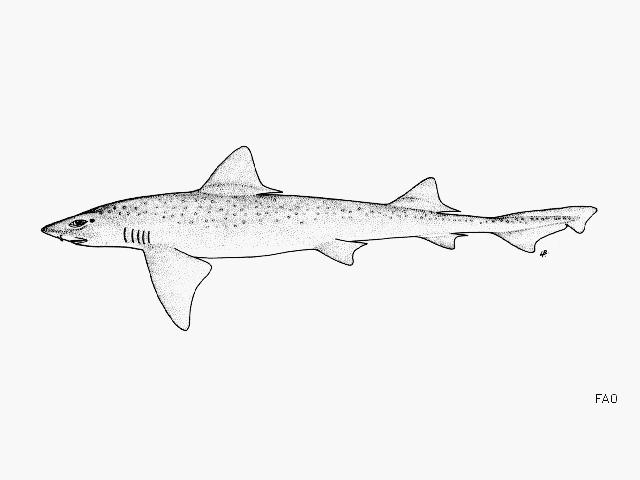Mustelus palumbes
Smith, 1957
Whitespotted smooth-hound
Classification: Elasmobranchii Carcharhiniformes Triakidae
Reference of the original description
A preliminary survey of the scylliogaliid dogfishes of South Africa. South African Journal of Science, 53(14), 353–359
A preliminary survey of the scylliogaliid dogfishes of South Africa. South African Journal of Science, 53(14), 353–359
Description :
Citation: Mustelus palumbes Smith, 1957: In: Database of modern sharks, rays and chimaeras, www.shark-references.com, World Wide Web electronic publication, Version 12/2025
Please send your images of "Mustelus palumbes" to info@shark-references.com

Mustelus palumbes Smith, 1957, © FAO, www.fish-base.org

Mustelus palumbes Smith, 1957, © FAO, www.fish-base.org
Common names
 Musola,
Musola,  Musola paloma,
Musola paloma,  Emissole palombe,
Emissole palombe,  Smoothound,
Smoothound,  Whitespotted smooth hound,
Whitespotted smooth hound,  Whitespotted smooth-hound
Whitespotted smooth-hound
 Musola,
Musola,  Musola paloma,
Musola paloma,  Emissole palombe,
Emissole palombe,  Smoothound,
Smoothound,  Whitespotted smooth hound,
Whitespotted smooth hound,  Whitespotted smooth-hound
Whitespotted smooth-hound
Short Description
Diagnosis after Compagno, 1984 [517]: Body fairly slender. Head short, prepectoral length 17 to 21% of total length; snout moderately long and bluntly angular in lateral view, preoral snout 6 to 7.4% of total length, preorbital snout 6.1 to 7.5% of total length; internarial space broad, 2.4 to 3% of total length; eyes fairly large, eye length 1.7 to 2.4 times in preorbital snout and 2.8 to 4% of total length; interorbital space moderately narrow, 3.7 to 4.7% of total length; mouth short, subequal to eye length. and 2.6 to 3.3% of total length; upper labial furrows longer than lowers and 1.7 to 2.5% of total length; teeth molariform and asymmetric, with cusp reduced to a low point, cusplets absent except in very young sharks; buccopharyngeal denticles covering almost entire palate and floor of mouth. Interdorsal space 18 to 23% of total length; trailing edges of dorsal fins denticulate, without bare ceratotrichia; first dorsal broadly triangular, with posteroventrally sloping posterior margin, its midbase closer to pectoral bases than pelvics; pectoral fins large, length of anterior margins 14 to 18% of total length, width of posterior margin 12 to 16% of total length; pelvic anterior margins 6.4 to 9.3% of total length; anal height 3.2 to 4.1% of total length; anal-caudal space greater than second dorsal height, and 7 to 8.8% of total length; ventral caudal lobe somewhat expanded and sometimes semi falcate in adults. Crowns of lateral trunk denticles lanceolate or weakly tricuspidate, with longitudinal ridges confined to their anterior halves or extending their entire length. Skeleton not hypercalcified in adults; palatoquadrates not subdivided; monospondylous precaudal centra 36 to 40, diplospondylous precaudal centra 43 to 52, precaudal centra 74 to 88. Colour uniform grey or grey-brown above, light below, usually with numerous small white spots but no dark spots or dark bars. Development ovoviviparous. Size large, adults 76 to 120 cm.
Diagnosis after Compagno, 1984 [517]: Body fairly slender. Head short, prepectoral length 17 to 21% of total length; snout moderately long and bluntly angular in lateral view, preoral snout 6 to 7.4% of total length, preorbital snout 6.1 to 7.5% of total length; internarial space broad, 2.4 to 3% of total length; eyes fairly large, eye length 1.7 to 2.4 times in preorbital snout and 2.8 to 4% of total length; interorbital space moderately narrow, 3.7 to 4.7% of total length; mouth short, subequal to eye length. and 2.6 to 3.3% of total length; upper labial furrows longer than lowers and 1.7 to 2.5% of total length; teeth molariform and asymmetric, with cusp reduced to a low point, cusplets absent except in very young sharks; buccopharyngeal denticles covering almost entire palate and floor of mouth. Interdorsal space 18 to 23% of total length; trailing edges of dorsal fins denticulate, without bare ceratotrichia; first dorsal broadly triangular, with posteroventrally sloping posterior margin, its midbase closer to pectoral bases than pelvics; pectoral fins large, length of anterior margins 14 to 18% of total length, width of posterior margin 12 to 16% of total length; pelvic anterior margins 6.4 to 9.3% of total length; anal height 3.2 to 4.1% of total length; anal-caudal space greater than second dorsal height, and 7 to 8.8% of total length; ventral caudal lobe somewhat expanded and sometimes semi falcate in adults. Crowns of lateral trunk denticles lanceolate or weakly tricuspidate, with longitudinal ridges confined to their anterior halves or extending their entire length. Skeleton not hypercalcified in adults; palatoquadrates not subdivided; monospondylous precaudal centra 36 to 40, diplospondylous precaudal centra 43 to 52, precaudal centra 74 to 88. Colour uniform grey or grey-brown above, light below, usually with numerous small white spots but no dark spots or dark bars. Development ovoviviparous. Size large, adults 76 to 120 cm.
Human uses
fisheries: minor commercial; gamefish: yes; price category: medium; price reliability: questionable: based on ex-vessel price for species in this genus
fisheries: minor commercial; gamefish: yes; price category: medium; price reliability: questionable: based on ex-vessel price for species in this genus
Biology
Ovoviviparous, embryos feed solely on yolk [733]. 3 to 8 young per litter. Born at around 25 cm. [20040]. Distinct pairing with embrace [17086]. Feeds on fish, crustaceans and mollusks [536].
Ovoviviparous, embryos feed solely on yolk [733]. 3 to 8 young per litter. Born at around 25 cm. [20040]. Distinct pairing with embrace [17086]. Feeds on fish, crustaceans and mollusks [536].
Remarks
shark-references Species-ID=3817;
shark-references Species-ID=3817;
Parasites (arranged by Jürgen Pollerspöck)
Cestoda
Copepoda
Cestoda
- Calliobothrium euzeti Bernot, Caira & Pickering, 2015 [21796] [27483] [27172]
- Symcallio peteri Bernot, Caira & Pickering, 2015 [21796] [27483] [27172]
Copepoda
- Kroyeria lineata Van Beneden, 1853 [22489] [27172]
- Lernaeopoda galei Krøyer, 1837 [29249]
- Pandarus bicolor Leach, 1816 [33255]
- Tripaphylus benzi Dippenaar, 2017 [25960] [27172]
- Tripaphylus hoi Dippenaar, 2017 [25960] [27172]
















